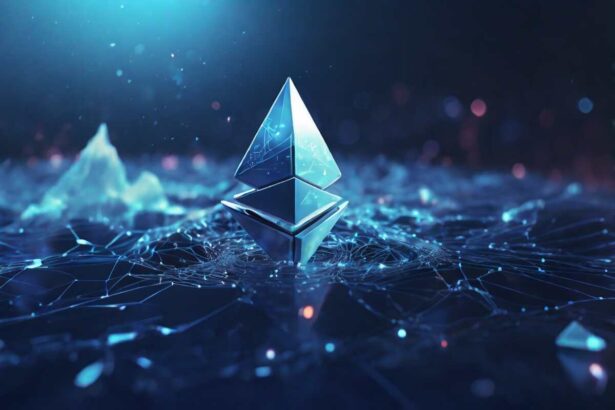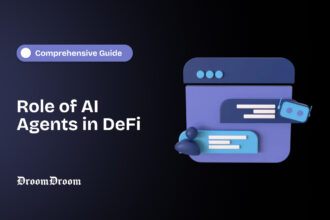The internet has evolved from being read-only, where only admins behind a website could interact with the system while the audience read-only, to the social age, where users can now read, create, and contribute. Account abstraction proposes a similar experience for crypto users, a new paradigm allowing users to get more engaged and participate in the crypto space.
- Understanding The Basics: Ethereum Account
- The Problems With Externally Owned Accounts (EOAs)
- What Does Account Abstraction Mean
- Advantages Of Account Abstraction
- Account Recovery
- Sponsored Transaction
- Risk-Free Gaming Session
- Gasless Transaction
- Multisig Wallet
- Batch Transaction
- Transaction Limits
- The Disadvantage of Account Abstraction
- How ERC-4337 Works
- History Of How ERC-4337 Happened
- Conclusion
Account Abstraction (AA) is among the latest sensations in the blockchain and crypto communities. The announcement of the new standard, ERC-4337, by the Ethereum team will finally bring to life the account abstraction that has been in discussion for almost a decade. While the concept of AA might sound confusing, unclear, and opaque to many, this article simplifies all you need to know, notably how AA will impact your interaction with crypto.
With account Abstraction, cryptocurrency users can perform more actions, such as completing a gasless transaction, adding two-factor authentication to their wallet, scheduling blockchain transactions, and having a recovery option for their private keys, meaning; they don’t need to worry about losing their 12-words recovery phrase.
Understanding The Basics: Ethereum Account
To comprehend account abstraction, known as the ERC-4337 standard, it’s crucial to revisit how Ethereum operates. This allows for familiarity with specific terms, why the new standard was introduced, how it will work, and other pieces that complete the puzzle regarding the topic.
Essentially, there are two types of Ethereum accounts; externally owned accounts (EOA) and contract accounts.
The externally owned accounts are self-controlled and are the most common Ethereum wallets; examples include MetaMask, Exodus, and Ledger Nano—anyone with the key pairs—private and public keys—control EOAs. Essentially, EOAs are used to interact with the blockchain.
On the other hand, contract accounts, best known as smart contracts, aren’t controlled by users but by the logic of codes. One core part of the contract account is that they can’t be altered or changed once launched. Unlike EOA, the user doesn’t control smart contracts; instead, they run as a program on the Ethereum Virtual Machine (EVM).
The Problems With Externally Owned Accounts (EOAs)
EOAs are one of the most novel concepts and have simplified how people interact with the Ethereum blockchain and its ecosystem. However, there are inherent problems that exist with the EOA accounts, which chiefly sit as a hindrance to massive adoption.
For transactions to be made on any EOA, they must be digitally signed by the account user. This is where the private and public keys play a role. The private key signs off a crypto transaction, implying a user’s approval. Without the private key, transactions can’t be completed on the blockchain.
Because of the way EOAs wallets such as MetaMask are designed, users’ private keys are encoded as secrets or recovery phrases and assigned to them. These phrases are expected to be stored safely as it guarantees ownership of the crypto assets on them. In a scenario where the user loses these recovery phrases encoding the private keys, It’s impossible to prove ownership of their crypto; that’s they’ll lose access to whatever assets are stored in the wallet.
Losing access to private keys has been an ample crisis and has been reported severally. In 2021, a report from Chain Analysis showed that over $140 billion, accounting for 20% of Bitcoins in circulation, has been lost due to no access to the wallet.
There are other limitations that come with using an EOA wallet. Another at the top of the list is the vulnerability to malicious attacks by bad actors, who can easily rob users of their funds and data. This flaw is based on the design of EOAs. For users of this type of wallet, despite possessing their private keys, the catchphrase “not your keys, not your crypto” also applies to them, as hacking incidents have become rampant.
The absence of flexibility on EAO wallets is a major setback. Users can’t finish off simple actions, such as enforcing a two-factor authentication on their wallet to provide extra security.
Authorizing automated transactions is only achievable sometimes. When interacting with a decentralized application, users are burdened with opening a new EOAs wallet, which is referred to as a “burner” account. The purpose of this burner account/wallet is to store the necessary amount of crypto, and it’s segregated from the user’s main account. This burner account will participate with the dApp in question. Automating this would have saved users from several stresses, such as storing another recovery phrase again, yet they are still vulnerable to hacks.
EOAs need a better user experience considering the limited actions possible on them—activities such as carrying out a batch transaction, permission control, and setting transaction limits are needed.
This isn’t an exhaustive list of limitations associated with EOA wallets. The existing design has constrained users’ crypto adoption, a significant setback. This has led Ethereum developers to invest time and resources into account abstraction to solve the major problems highlighted above.
What Does Account Abstraction Mean
Account Abstraction, in its simplest form, means programmable and customizable wallets. An ideal visualization is that users can now use smart contract wallets to carry out all their transactions rather than depend on EOAs. They are combining both externally owned accounts and contract accounts as one.
The announcement for AA was made by Yoav Weiss, an Ethereum Foundation security researcher, and later on, publicized on Twitter. “The rumors are true… ERC-4337 has been deployed on mainnet 🚀.” Weiss noted the remarkable feat stood after ERC-4337 passed an audit by Open Zeppelin.
The rumors are true… ERC-4337 has been deployed on mainnet 🚀
🔍 Security audit by @OpenZeppelin
🛠️ Bundlers and paymasters by @stackup_fi, @AlchemyPlatform, @biconomy , @etherspot, @candidewallet, @blocknative & more
🏗️ $300K in grants by @ethereum pic.twitter.com/WOjMvaZe6M
— erc4337 (@erc4337) March 2, 2023Advantages Of Account Abstraction
Several benefits are linked to using an abstracted wallet rather than the EOAs. The benefits sprout from the customizability of the wallet. Some of the benefits of AA are listed below:
Account Recovery
Very self-custodian wallet or EOA provides users with a seed phrase containing their account’s private key. Without this, key transactions can’t occur in the wallet. Frequently, users lose this key. With account abstraction, the chances of a user losing their account are slim. This is possible via the social recovery method that allows users to assign trusted individuals or commercial services to act as recovery agents for the account. Now users can handle cramming or losing their seed phrase.
Sponsored Transaction
This feature of account abstraction is a game changer for dApp developers. It opens the opportunity to increase product adoption by implementing facets such as removing transaction fees for new users. This provides a frictionless experience for new users who would have otherwise gone through the tedious process of purchasing Ethereum on a centralized exchange before transferring to the dApp.
Risk-Free Gaming Session
This feature here will revolutionize web gaming. Now, web3 gamers can link their wallet directly to the game, limit the number of transactions, and set limits for the total removable amount. Each transaction doesn’t need to be signed, unlike before. This added flexibility and an extra layer of security.
Gasless Transaction
Account abstraction will bring gasless transactions to life. These types of transactions are referred to as Meta-transactions. Meta transactions allow the receiver to pay for the gas instead of the sender.
Multisig Wallet
These wallets require the signature of two or more parties (pre-determined addresses) before a transaction can be completed. On EOA wallets, transactions are initiated first; then, the multisig smart contract is requested to complete. This process could be more efficient and effective. With account abstraction, the wallet can exist as a multisig account without requesting an external multisig contract.
Batch Transaction
Unlike with the EOA, where every transaction can’t co-occur, a smart contract wallet allows users to batch or bundle send a token or coin in the same transaction.
Transaction Limits
The new Ethereum standard will allow wallets to be configured such that users can set a transaction limit in their account. This is not available with EOAs.
There are a plethora of opportunities attached to the new Ethereum standard; this flexibility changes the entire landscape of user interaction and adoption. In Weiss’s words, “It gives you the same features a bank would without having to trust a bank,” adding that “the next billion users are not going to write 12 words on a piece of paper. Normal people don’t do that… We need to give them better usability, they shouldn’t need to think about cryptographic keys.”
The Disadvantage of Account Abstraction
The idea behind account abstraction is novel; however, it has shortcomings. These setbacks don’t outweigh the benefits. Some of the gray areas with account distraction currently observed are:
Vulnerability
This is the foremost problem with account abstraction. Smart contract users’ funds might get breached with hackers siphoning the funds off.
Lack of Understanding
Since account abstraction is still in the early stages, there need to be more educational resources that help guide users on how to set up an account or even properly carry out transactions.
Data and Privacy Breach
Users’ data can be accessed if security measures to prevent such an event properly aren’t put in motion by developers.
How ERC-4337 Works
Account abstraction has been a long conversation but never garnered attention because of the model proposed in the past. Introducing AA in the previous proposal would have led to a significant change in Ethereum’s core, causing a fork.
A crypto fork happens when there is a change in the underlying rules for the blockchain network or protocol. It happens when the community decides to take different paths, leading to a split in the chain. An example was the Ethereum network hard fork that led to Ethereum and Ethereum classic.
It was until 2022 that the Ethereum team proposed EIP-4337, which relies on a high-level system referred to as the mempool, that account abstraction became visible. The community embraced the EIP-4337 since it was to be deployed as a smart contract connoting that the Ethereum network would remain the same.
The ERC-4337 moves all transactions off the Ethereum blockchain and onto the Ethereum Virtual Machine (EVM) compatible networks, including Polygon, Abitrum, Avalanche, etc. This significant upgrade adds to the flexibility and ability to customize the network.
While the idea of account abstraction is new on the Ethereum blockchain, certain layer-two chains have executed something similar. Starknet and zkSync are found in this category, providing a similar, non-holistic package as seen with the ERC-4337 standard.
History Of How ERC-4337 Happened
ERC-4337 has been a work in progress for the Ethereum community; it was shipped after a period of iterations. The Ethereum foundation had submitted multiple proposals over the years on account abstraction before finally arriving at this point.
EIP-86
In 2016, the foundation submitted its first proposal for account abstraction. It proposed authorizing multiple parties to run a single account rather than relying on codes.
EIP-2938
Proposed in 2020, it introduced the “AA transaction,” which would allow transactions to be initiated first from a smart contract as opposed to the EOA.
EIP-3074
Still, in 2020, the foundation presented another proposal. The aim here was to grant smart contract control over EOAs. It ultimately made the EOA mimic the smart contract without deploying any contract.
None of these proposals was accepted due to a significant change that would cost the Ethereum network. It will lead to a notable difference in the network’s consensus layer, hence causing a fork.
EIP-4337
This was the game changer. In 2021, it was introduced and admitted as the ideal standard mainly because it planned to bring account abstraction to life without any network change.
Conclusion
Ethereum is one of the world’s most prominent blockchains and has ushered in a new era for finance. The team has been seriously dedicated to improving the network capacity, interoperability, and usage. This upgrade is significant in onboarding more participants into the crypto industry. It eliminates barriers that hinder involvement and introduces a novel concept that improves the useability of the Ethereum network, especially in carrying out activities possible on traditional finance application. More education needs to be present to prepare users on how the new technology will function and how users can utilize it.



















